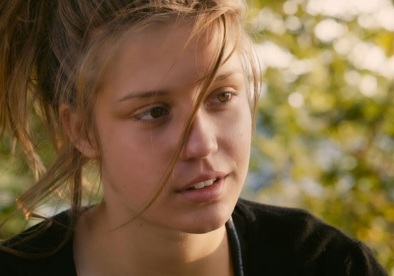“Oh you’re in my blood like holy wine/You taste so bitter and so sweet/Oh I could drink a case of you darling/Still I’d be on my feet/Oh I would still be on my feet”
—“A Case of You” by Joni Mitchell
Yes, we are talking about that movie. But before delving into what makes Adele of Blue is the Warmest Color an Outside Girl, let me preface this post with this disclaimer: The film is one minute shy of three hours and–at most–devotes only 15 minutes to scenes of explicit coupling. This movie features sex, but is also about a lot more than that. Okay, the lecture is over now.

Believe it or not, I’m more interested in how this incredible film depicts everyone’s favorite subject: love. For those of you unaware of Blue, here is the rundown: It is very loosely based on Julie Maroh‘s awesome graphic novel, Blue Angel. In addition, it explores the years-long relationship between two women (one is older, cultured and experienced; the other is younger, working class and green) from when their paths first cross to when their paths permanently diverge. It is fantastic. Especially because director Abdellatif Kechiche decides to acknowledge that romance is just as likely to destroy a person as it is to build her up. You see, as high school aged Adele becomes more and more wrapped up in college student Emma, the more she cuts herself off from everything else in her own world.

It is no revelation when I say that individuals can lose their own sense of self when they become part of a couple. A colleague of mine (thinking himself very wise) once said when you are in a relationship, your status shifts from “me-dom to we-dom.” Violations of the English language aside, the core of his sentiment does have some bearing on reality. We have all had friends who become so dedicated to their romance that they have little time for anything else. Scholar Caroline E. Jones recently studied the way burgeoning female sexuality and first sexual experiences are presented on television. She argues that the female protagonist often “constructs a social or public identity that reveals, complements, or masks her personal or private identity; the double-process of self-perception and self-construction helps her frame…her emerging sense of herself as sexually active.”
For the record, Jones only applies her claim to Buffy Summers, Veronica Mars and Rory Gilmore and analyzes how their initial sexual experiences shaped their characters. However, the stance Jones takes is extremely relevant to Adele and her head-over-heels fall for Emma. Adele is not ashamed of her sexuality, exactly. But she is very private about her feelings and her relationship. For example, both women meets the other’s parents. Emma’s parents know who Adele really is, but Adele’s parents are under the impression that Emma tutors Adele in philosophy. As the commitment between these two women intensifies, the less Adele has to do with her own individual life. When the two first meet, Adele has a large circle of friends, a boyfriend and spends time with her parents every day. By the time the two move in together, Adele only socializes with Emma’s colleagues and friends. It is almost as if Adele has no sense of herself without Emma. It’s like her previous life never even existed.

To be clear, Jones does not argue that Buffy, Veronica and Rory all lose their individuality once they embark on a sexual relationship. But there is a perceivable shift in the way they see themselves and their lovers. Adele goes through this transformation too, even if it is more extreme than Jones documents in her study. Many critics have argued that economic status is what eventually drives these two women apart. A.O. Scott notes that the “subtle, unmistakable class difference” is punctuated by the aforementioned dinner scenes. Emma’s parents serve oysters; Adele’s family serves spaghetti. It’s true that the differing class status puts strains on their romance, but I would argue that their respective sense of self is the ultimate catalyst for their breakup. As Scott describes, “Emma is proudly out. Adele is, somewhat defiantly, closeted.”
Revealing one’s sexuality is an inherently personal decision. Just as I believe that no one should be attacked or discriminated against based on his or her sexual orientation, I don’t automatically think anyone should be pressured to divulge something that he or she is not ready to share. In my opinion, Adele has every right to keep her sexuality private, but I can also understand how it fractures her relationship with Emma. Adele’s isolation is her own unconscious construction. She is so in love and is so hesitant to publicly discuss it that her lover eventually becomes her entire world.

That puts a lot of pressure on Emma and would be too much for many people to handle. During their devastating breakup scene, Adele confesses to cheating on Emma and tells her, “I felt so alone.” She is alone, even when she is deliriously happy in her relationship. For all of their intense chemistry and genuine affection for each other, these two women come from completely different worlds. Shy Adele, who aspires to be a teacher, will never really fit with Emma, an artist whose emotions are just as visible as her electric-blue hair. Adele does not understand this until it is too late. From the moment she sees Emma, she barrels forward and sacrifices everything so she can be with her. The cruel irony of this beautiful film is that Adele’s willingness to give up everything for love is exactly why she loses it.
(Image #1 courtesy of aceshowbiz.com; #2 courtesy of teatopour.blogspot.com; #3 courtesy of athenacinema.com; #4 courtesy of galleryhip.com)